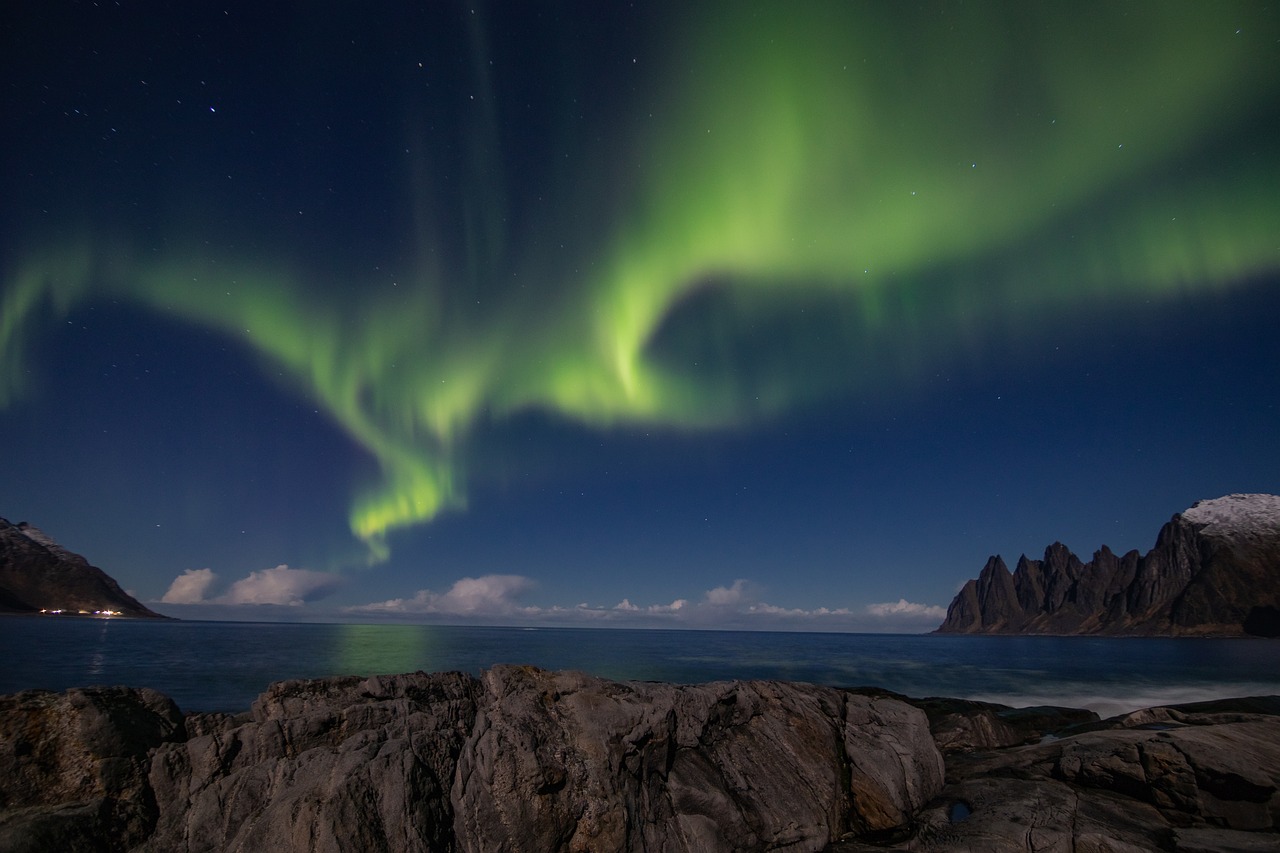The enigmatic phenomenon known as the Aurora, often referred to in various cultures as the Valkyrior or “Dance of the Spirits,” captivates the human imagination with its ethereal beauty and mystique. Originating from the Roman goddess of dawn, Aurora, and the Greek term for the north wind, Boreas, these natural wonders are classified as the Aurora Borealis in the Northern Hemisphere and Aurora Australis in the Southern Hemisphere.
Typically, the auroras are best observed within latitudes of 60 to 72 degrees north or south, situating them within the Arctic and Antarctic polar circles. While these luminous displays can occasionally be spotted at lower latitudes, sightings are far rarer. Hence, traveling to the polar extremes significantly increases your chances of witnessing and capturing this breathtaking spectacle.
For those eager to dive deeper into the science behind the Auroras, including their origins and the spectrum of colors they produce, a plethora of literature and online resources can provide extensive information. This discussion will focus specifically on photography techniques to help you immortalize this extraordinary experience through your lens.
Preparing for Your Aurora Adventure
If you’re gearing up to photograph your first Aurora, an understanding of the pertinent conditions is crucial. Your success will hinge on local weather scenarios, your patience, and the geographic position you choose. Observing the Aurora requires darkness, minimal light pollution, and, of course, a good measure of luck.
The overriding requirement here is indeed patience. This undertaking often demands enduring freezing temperatures; hence your likelihood of success in capturing stunning images is largely dependent on your willingness to brave these elements.
Choosing the Perfect Location
The primary step is to find a location conducive to Aurora sightings. In the Northern Hemisphere, the ideal latitudes lie firmly within the Auroral Zone—between 65 and 72 degrees north. Notable spots include Tromsø in Norway, Yellowknife in Canada’s Northwest Territories, and Bettles in Alaska. Other regions such as Svalbard, Jukkasjärvi in Sweden, Kakslauttanen in Finland, Kangerlussuaq in Greenland, and Reykjavik, Iceland also provide excellent conditions for observation.
In the Southern Hemisphere, prime locations that offer views of the Aurora Australis include Ushuaia, Argentina, Tasmania, Australia, Stewart Island in New Zealand, and the southern tip of South Africa.
Essential Preparations
When setting out for a nocturnal photography session, prepare adequately. Here are some vital considerations:
- Remain vigilant of your environment, especially in unfamiliar areas.
- Exercise caution while navigating through snow or ice.
- It’s advisable to partner up with someone sharing your enthusiasm or at least someone who can provide support.
- Scout your destination during daylight to identify potential hazards, plan your path, and assess snow and ice conditions.
- Inform someone about your photography plans and expected return times.
Dressing Appropriately
Choosing the right clothing in accordance with the season and weather is paramount for both comfort and safety during extended outdoor exposure to harsh temperatures. Don layers of moisture-wicking and insulating clothing to combat the cold effectively.
Always ensure you have a reliable source of light, such as a flashlight or headlamp (with a red filter to preserve night vision), and carry spare hand warmers for both yourself and your camera gear. Insulated boots and warm drinks will enhance your experience significantly.
Equipment Essentials for Aurora Photography
While you don’t need extensive gear to photograph the Aurora, certain items are indispensable:
- Camera: A camera with interchangeable lenses is ideal, although a high-quality smartphone can suffice. However, a camera fitted with a sturdy tripod will yield better results.
- Lens: A wide or super wide-angle lens (10-24 mm focal length) with a wide aperture (f/1.2-2.8) is best for capturing the vastness of the landscape alongside the Auroras.
- Tripod: A reliable tripod is crucial for preventing movement blur. Ensure it’s built to withstand low temperatures.
-
Remote Shutter Release: This accessory minimizes camera shake when taking long-exposure shots, crucial for capturing the brilliance of the auroras.
-
Extra Memory Cards and Batteries: Cold weather can deplete batteries quickly, so always have spares available. Keep spare batteries warm in your jacket to preserve their charge.
-
Waterproof Dry-bag: Protect your equipment from moisture during quick temperature fluctuations. Include silica gel packs to trap condensation.
Capturing the Aurora
Employ these strategies for securing captivating images of the Aurora:
- Use RAW format for maximum image data.
- Avoid protective filters when capturing the Aurora to eliminate unwanted effects in your images.
- Switch your camera to manual mode and disable the flash.
- Set the focus to slightly back from infinity to maintain clarity.
- Use wide apertures and set the shutter speed to “Bulb” for long exposure times, adjusting as necessary based on the activity of the aurora.
- Begin with an ISO setting around 800 and modify it according to the results and the conditions.
- Include an interesting foreground to offer depth and perspective in your composition.
If this is your first experience or if you’re exploring a new location, consider joining guided tours. They enhance your chances of witnessing the Auroras, equipped with locals’ knowledge and expertise.
Embracing the Experience
Witnessing the awe-inspiring Aurora is a life-changing experience, instilling a sense of wonder and excitement. Photographing it allows you to encapsulate this magical dance, preserving the enchantment for years to come. Though getting to the right place can be challenging, the time and effort are well worth it when faced with the captivating spectacle of nature’s light show.
As you look up to the night sky in the future, remember that the Auroras await, ready to mesmerize you once again.



